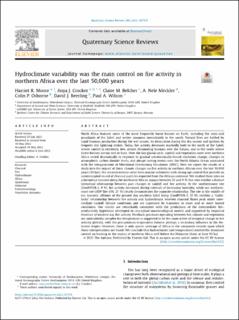| dc.description.abstract | North Africa features some of the most frequently burnt biomes on Earth, including the semi-arid grasslands of the Sahel and wetter savannas immediately to the south. Natural fires are fuelled by rapid biomass production during the wet season, its desiccation during the dry season and ignition by frequent dry lightning strikes. Today, fire activity decreases markedly both to the north of the Sahel, where rainfall is extremely low, almost eliminating biomass over the Sahara, and to the south where forest biomes are too wet to burn. Over the last glacial cycle, rainfall and vegetation cover over northern Africa varied dramatically in response to gradual astronomically-forced insolation change, changes in atmospheric carbon dioxide levels, and abrupt cooling events over the North Atlantic Ocean associated with the reorganisation of Meridional Overturning Circulation (MOC). Here we report the results of a study into the impact of these climate changes on fire activity in northern African over the last 50,000 years (50 kyr). Our reconstructions come from marine sediments with strong age control that provide an uninterrupted record of charcoal particles exported from the African continent. We studied three sites on a latitudinal transect along the northwest African margin between 21 and 9°N. Our sites exhibit a distinct latitudinal relationship between past changes in rainfall and fire activity. At the southernmost site (GeoB9528-3, 9°N), fire activity decreased during intervals of increasing humidity, while our northernmost site (ODP Site 658, 21°N) clearly demonstrates the opposite relationship. The site in the middle of our transect, offshore of the present day southern Sahel today (GeoB9508-5, 15°N), exhibits a “Goldilocks” relationship between fire activity and hydroclimate, wherein charcoal fluxes peak under intermediate rainfall climate conditions and are supressed by transition to more arid or more humid conditions. Our results are remarkably consistent with the predictions of the intermediate fire-productivity hypothesis developed in conceptual macroecological models and supported by empirical evidence of modern day fire activity. Feedback processes operating between fire, climate and vegetation are undoubtedly complex but temperature is suggested to be the main driver of temporal change in fire activity globally, with the precipitation-evaporation balance perhaps a secondary influence in the Holocene tropics. However, there is only sparse coverage of Africa in the composite records upon which those interpretations are based. We conclude that hydroclimate (not temperature) exerted the dominant control on burning in the tropics of northern Africa well before the Holocene (from at least 50 ka). | en_US |

